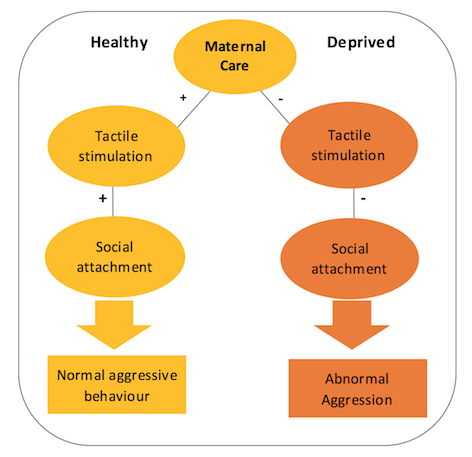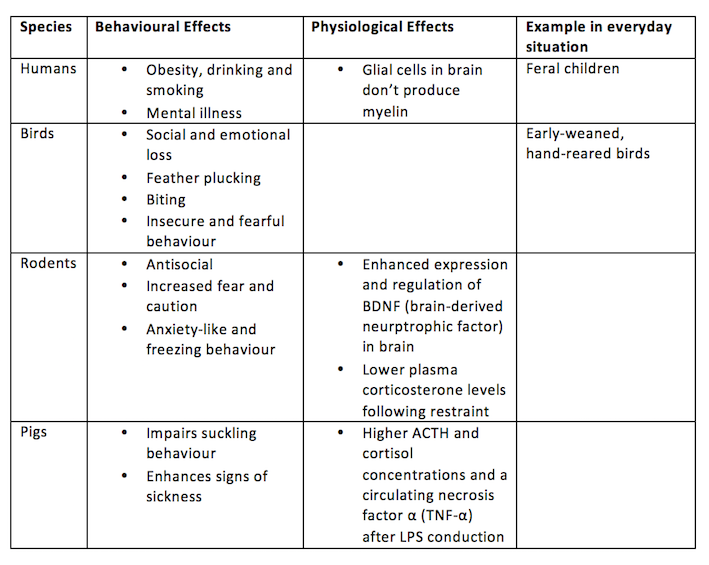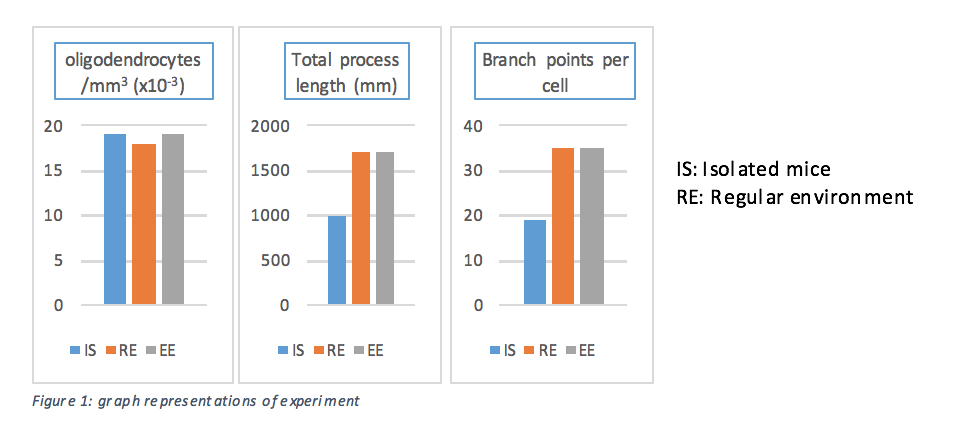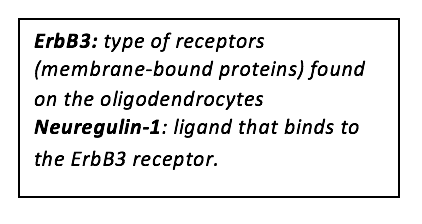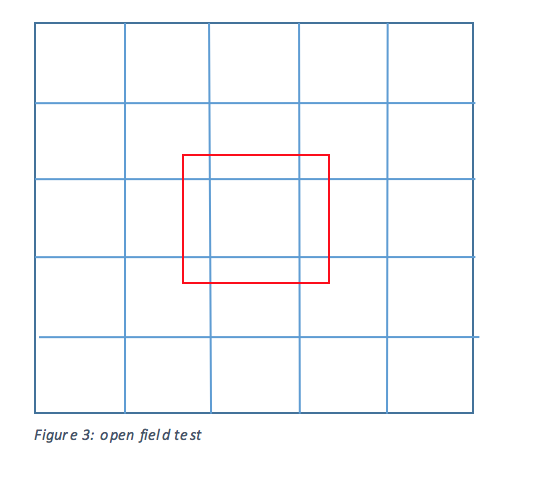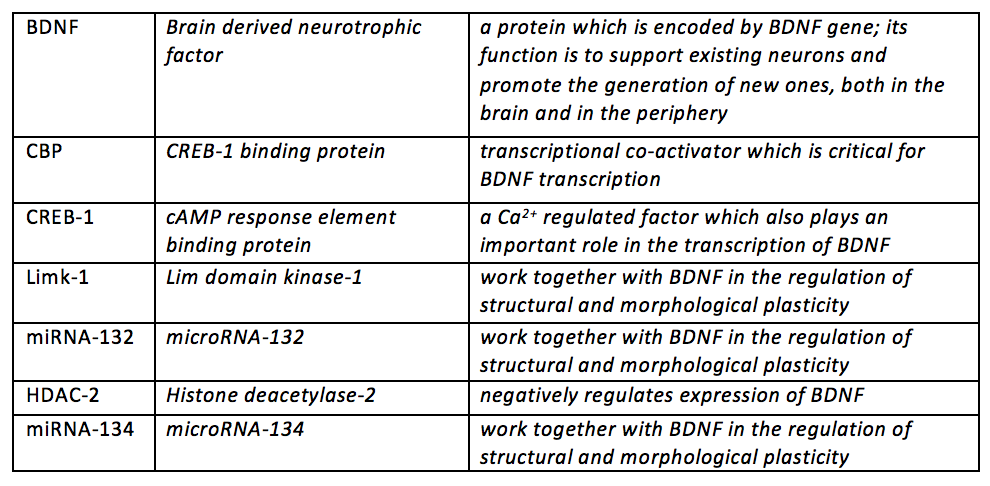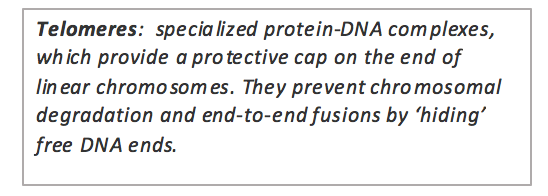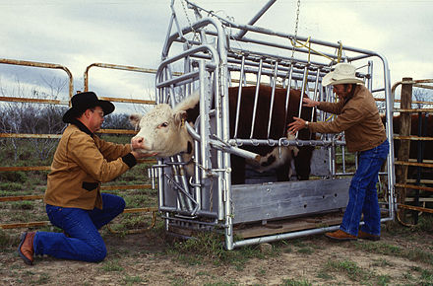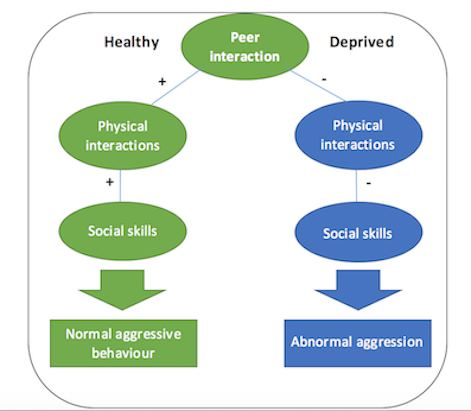Physiological And Behavioural Effects Of The Early Social Isolation
Social isolation is the experience of physically being alone and in solitude. It may even just be a perception; someone may feel isolated despite being surrounded by people. Short term solitude is not regarded as social isolation. Early social isolation can impede the behaviour and physiology of many types of species.
As science continues to evolve, social isolation is being given more importance. In fact, Martha McClintock, a university of Chicago psychology professor, explains how the increase in morbidity with social isolation is equal to that of cigarette smoking. Experiments and research are continuously being made on both humans and animals. Animal-based research allows us to make new discoveries without the risk of causing permanent damage to humans.
Social isolation may affect both the young and elderly, and has different behavioural, physiological and hormonal effects on the differently aged individuals. In this text we will focus on the effects of social isolation on early development, particularly during the critical period. This is a maturation stage during which the nervous system is extremely sensitive to certain environmental stimuli.
Contents
Main Effects
It has been proved that disorders in mother-infant relationships and early social isolation contribute to increased aggression in adult life. Decreased social stimulation in young may therefore cause stress and promote aggressive behaviour.
The strong mother-infant relationship, which is seen in most species, contains high amounts of tactile stimulation and is important for nervous system and behavioural development.
|
Apart from behavioural effects, several physiological ones are also seen.
|
Effects on different species
Here we will have a look at some experiments which were conducted on different species and discuss the results obtained.
Humans
In humans, similarly to other species, early social isolation causes cognitive and social problems which will impinge on the individuals for their whole lives. Children who are kept isolated are withheld from certain experiences which are fundamental for normal mental and physical development, and hence suffer long-lasting behavioural impairments. To begin with, they are unable to develop basic social skills and grow up to be cognitively and socially impaired. Solitude also results in them not acquiring language, forcing them to resort to nonverbal basic communication and interaction, hence preventing them from ever expressing themselves through words. Naturally, they will subsequently suffer from lower educational attainment. Social isolation is also associated with increased chances of social distress, mental illness, obesity and smoking in adults.
A good example of how seclusion from the rest of the world effects children, is Genie Wiley. Genie is a woman who was kept almost entirely isolated until the age of 13. When the authorities found and rescued Genie, her case drew the attention of many scientists and researchers, who saw her as an opportunity to study many aspects of human development. Furthermore, when people learnt that Genie had not yet picked up on language, linguists saw her as a chance to learn more about language acquisition skills and to help determine the critical period during which humans grasped the understanding and use of language. After many years of being tested on, Genie developed some very basic social skills, however she never attained the ability to speak and verbally communicate with others (Curtiss, 1977; Curtiss et al., 1975).
Rodents
Several studies have been conducted on rodents to help us understand the irreversible life-long effects caused by early social isolation.
- A group of scientists from Boston (Makinodan et al., 2012) took 21 day old mice right after weaning and placed them in one of 3 conditions for 2 weeks. Some were kept in groups of 4, others were reared in an enriched environment with other mice and toys, and the third group were kept in solitude. At 50 days old all the mice were tested for sociability, using a social interaction test and working memory, using a non-matching-to-place task. The isolated mice had difficulty with both tests.
Then they examined the brains of all 3 groups of mice. Some abnormalities were noted in the isolates, who were found to have strange, stumpy oligodendrocytes, as opposed to the normal long, complexly branched oligodendrocytes. Oligodendrocytes are cells in the brain forming an important part of the neural system.
|
- Following these discoveries, they went on to uncover the cause of white matter damage in the socially isolated mice. These alterations in medial prefrontal cortex (mafic) function and myelination occur when mice are isolated between days 21 and 35, making this the ‘critical period’ of oligodendrocyte maturation. They learnt that keeping the mice in solitude during this time period resulted in a loss of ErbB-3 receptor signalling on the oligodendrocytes, as well as reduced expression of neuregulin-1. These findings indicate that juvenile social experiences have a great impact on prefrontal cortex myelination through neuregulin-1/ErbB3 signalling, and that this signalling is essential for normal cognitive function. This study provides a cellular understanding of the consequences of early social isolation (Makinodan et al., 2012). Similar studies on both neglected children (Chugani et al., 2001) and Rhesus monkeys (Sanchez et al., 1998) show similar effects on white matter caused by social isolation in juveniles.
|
A recent study (Kumari et al, 2016) performed on 2-month-old female mice isolated for a period of 2 months, examined anxiety-like behaviour that develops most frequently in females due to early social isolation. Similar, but much less prominent effects are also seen in males. Tests used included the elevated plus maze test and open field test. In the elevated plus maze test, isolated mice were much less mobile than the group-reared mice in the open arms, while in the closed arms, locomotion was rather equal. Isolated mice also preferred staying in the closed arms, and spent very little, if any, time in the open arms.
|
In the open field test, contrary to the group mice, the isolated mice were only slightly mobile, staying mostly in the periphery of the field, while avoiding the central zone.
|
- These two tests proved anxiety-like behaviour caused by social isolation.
RNA from both groups of mice, was collected and analysed, Semi quantitative reverse-transcription polymerase chain reaction (RT-PCR), Quantitative real-time PCR and Western Blotting were performed in order for statistical analysis to be performed on the RNA samples. Statistical analysis showed that BDNF, CBP, CREB-1 and Limk-1 and miRNA-132 in the cerebral cortex were all up-regulated by social isolation. In contrast, HDAC-2 and miRNA-134 in the cerebral cortex were down-regulated by social isolation.
|
- BDNF expression has previously been found to increase anxiety-like behaviour in female rodents. That and the fact that social isolation increases the expression of BDNF in female mouse brains leads us to the conclusion that social isolation in case of female mice results in increased anxiety.
- A study conducted by Lukkes et al. (2008) tested fear and anxiety behaviour and corticosterone stress levels in male rats which were either kept isolated or in groups of 4 from when they were 21 days old. After 3 weeks in these conditions, the rats were kept together for further 2 weeks. At the end of the 5 weeks, the now-adult rats were examined for unconditioned and conditioned fear behaviour, open-field anxiety-like behaviour, social interaction behaviour and corticosterone responses to restraint stress. The data obtained from the several tests performed shows that, when compared to group-raised rats, the isolated rats showed increased fear and anxiety-like behaviour in a brightly-lit open field test, as well as increased fear behaviour to a conditioned stimulus predicting foot shock. In the social interaction test, isolated rats were more cautious, displayed lower number of social encounters and increased freezing behaviour. An interesting observation from restraint-stress test (where rats are placed in a narrow tube, allowing just enough movement for breathing, for 10 minutes) revealed no immediate difference between plasma corticosterone levels of group-raised and isolated rats, however 2 hours after, the isolated rats were found to have significantly lower plasma corticosterone levels, when compared to their respective pre-stress levels. This study therefore concludes that isolation during early development not only increases anxiety-like and fear behaviours, but also results in decreased levels of plasma corticosterone following restraint stress.
- Increased motivation for alcohol and cocaine is another possible effect of early social isolation in rodents. Studies show that when young animals are isolated, they are deprived of social play, which is important for proper social, emotional and cognitive development, this has life-long consequences such as increased consumption and motivation for alcohol. (Lesscher et al., 2015) Similarly, isolated rats also showed increased motivation to self-administer cocaine. (Baarendse et al, 2014) Re-socialisation of the rats did not reverse these behaviours, further emphasizing the importance of socialisation during the critical period of development (days 21-35 in case of rodents).
Dogs
Too little social exposure during the critical period could have long lasting behavioural effects in puppies, including; fear and aggression towards strangers and fear of children, hyperactivity and decreased learning ability. Studies regarding social isolation in dogs are limited, however it has been proved that a puppy that does not receive proper social experience during the critical period will be subject to unpredictable and inconstant behaviour. During the critical period (approx. between week 4 and 10) puppies are very sensitive and vulnerable to psychological injuries since the nervous system is still developing. (Nottenbohm, 1980).
Cats
Kittens taken away from their mother and litter mates, other offspring having the same age and mother, and placed in an unfamiliar environment, tend to increase distress cries and disorientation, when compared to kittens in the presence of littermates or their mother, thus proving the formation social attachments.
2-week-old kittens were once a week placed in an open field with a brooder-replicate and a mechanical toy for a period of 4 weeks. The results obtained were that the brooder-reared kittens spent more time with the fear-stimulating mechanical toy than the mother-reared kittens. The mother-reared kittens vocalized more, but moved less than the brooder-reared ones. These results conclude that the mother-reared kittens form attachments with the mother and are less independent, whereas brooder-reared kittens do not form social attachments with the brooder, and grow up to be more independent (Guyot et al., 1983).
Birds
Like in other species, early socialisation in birds is a very important factor for the behaviour and health of the adult animal. This is proved from the results drawn from some experiments concerning the highly social African Grey Parrot.
The African Grey Parrot is an extremely sociable bird. The experiment, based on the age and living conditions of individual birds, required both single-housed and paired-housed parrots aging between 0,75 to 45 years old. The findings provide evidence that social isolation affects telomere length (Aydinonat et al., 2014).
|
The single-housed birds showed increasing stress compared to paired-housed birds. The exposure to such stressful conditions may be the cause of damage to DNA, especially in the telomeric region, in birds.
In conclusion, social isolation may be harmful for the health and normal behaviour of many species of birds, not only the African Grey Parrot, as they are very social animals.
Chickens, a farm-animal bird species, also suffer from early weaning from the mother and the other chickens. A consequence of social isolation in chicks is increased corticosterone levels, interestingly females show stronger resistance than males.
Farm animals
As opposed to what many people think, farm animals also suffer from issues of early social isolation. Sometimes we forget that they too are animals and that they are not just there to serve as produce.
We can detect the negative effects of the social isolation through observations and experiments in many species. For example, in the Pig the maternal deprivation may cause very severe results in the animals’ health and behaviour. In one of the experiments, domestic piglets, from 3-11 days old, were isolated for 2 hours every day. The piglets showed some abnormalities in behavioural, endocrine and immune responses to an endotoxin challenge with lipopolysaccharide. Early isolated piglets responded to LPS by an increase of shivering on day 12 and by increased vomiting on day 56. These abnormalities were concerned with signs of sickness and impaired suckling behaviour (Tuchscherer et al., 2006).
Small ruminants, like sheep and goats, are also affected by early social isolation. Through the breeding of these species, it was observed that the young animals that were weaned early found problems when looking for and picking the right food, probably due to not having time to learn the appropriate way from their mothers.
Larger ruminants, like cows, also showed some sensitivity on the issue of isolation from their mother and generally from their environment. The main reason of their isolation is the artificial weaning, that usually takes place at about 8-9 months old. This situation is very stressful for the calves, as seen from the increase in plasma cortisol level and the circadian rhythmic activity. In contrast, the calves that were weaned at an older age, showed healthier responses; they reacted more actively to being handled in a crush and showed higher cardiac responses to conditioned fear.
|
Another species which is really affected by the social isolation is the horse. Foals that are restricted to a stable in their early development, face many psychological problems which may lead to behavioural problems. Observations showed self-mutilating behaviour issues such as flunk biting in stallions, stereotyped pacing or box-walking, whinnying and pawing. Another main characteristic of this situation is the extensive aggression of the animal, which leads to inappropriate behaviour not only towards humans, but with other horses too. This negative behaviour will result in mishandling of the horses and further abnormal development of their character.
Prevention
Physical interaction with members of the same species is important for the proper development of social competence and skills.
Massaging premature human babies enables them to acquire supplemental tactile stimulation and has proved to increase behavioural development and also gain in body weight (Field et al., 2009)
In order to prevent early social isolation there are legislations in place for animals such as dogs, cats, chimpanzees and rabbits that prohibit early weaning. The Dutch parrot foundation in the Netherlands is campaigning to include parrots as an animal that should be prohibited from being weaned early and hand-reared.
|
Conclusion
Social isolation of premature individuals affects both their mental health and behaviour. It is important for offspring to be exposed to their surroundings, especially during the critical period of their development, this will allow for proper learning of skills and appropriate behaviour. Most of these traits are picked up from the mother or else learnt by interacting with other offspring of the same species. Socialisation is also important for proper mental function and for the organism to reach its full learning potential.
References
- Aydinonat D, Penn D.J, Smith S, Moodley Y, Hoelzl F, Knauer F, Schwarzenberger F (2014) Social Isolation Shortens Telomeres in African Grey Parrots (Psittacus erithacus erithacus) PLoS ONE 9(4): e93839
- Baarendse PJ, Limpens JH, Vanderschuren LJ. (2014) Disrupted social development enhances the motivation for cocaine in rats. Physiological Pharmacology 231(8):1695-704
- Baars AM, Hesseling P, Janseen MJ, Lesscher HM1, Lozeman-van't Klooster JG, Spoelder M, Rotte MD, Vanderschuren LJ. (2015) Early social isolation augments alcohol consumption in rats. Behavioural Pharmacology 26: (7) 673-80
- Baghel MS, Kumari A, Singh P, Thakur MK. (2016) Social isolation mediated anxiety like behaviour is associated with enhanced expression and regulation of BDNF in the female mouse brain.Physiological Behaviour 158 : 34-42
- Behen M.E.; Chugani H.T.; Chugani D.C.; Juhasz C.; Muzik O.; Nagy F. (2001) Local brain functional activity following early deprivation: A study of postinstitutionalized Romanian orphans. Neuroimage 14: (6) 1290-301
- Bennet T.L, Cross H.A, Guyot G.W. (1983) Early social isolation of the domestic cat: Responses during mechanical toy testing. Applied Animal Behaviour Science 10: (1-2) 109-116
- Corfas G, Ito S, Makinodan M, Rosen KM. (2012) A critical period for social experience-dependent oligodendrocyte maturation and myelination. Science 14:337 (6100) 1357-60.
- Curtiss, Susan (1977): Genie: A Psycholinguistic Study of a Modern-Day Wild Child, Perspectives in Neurolinguistics and Psycholinguistics, Boston, MA: Academic Press, ISBN 978-0-12-196350-7, OCLC 3073433
- Curtiss, Susan; Fromkin, Victoria A.; Krashen, Stephen D.;Rigler, David; Rigler, Marilyn; (1975), An update on the linguistic development of Genie (PDF), in Dato, Daniel P., Developmental Psycholinguistics: Theory and Applications, Georgetown University Round Table on Languages and Linguistics, Washington, D. C.: Georgetown University Press, pp. 145–153, ISBN 978-0-87-840110-9, OCLC 2114555
- Diego M, Field T, Herndandez-Reif M. (2009) Preterm Infant Massage Therapy Research: A Review. Infant Behavioural Development 33: (2) 115–124
- Do D, Hearn EF, Herndon JG, Rilling JK, Sánchez MM. (1998) Differential rearing affects corpus callosum size and cognitive function of rhesus monkeys. Brain Research 812:38.
- Forster G.L., Lukkes J.L., Mokin M.V., Scholl J.L. (2009) Adult rats exposed to early-life social isolation exhibit increased anxiety and conditioned fear behaviour, and altered hormonal stress responses. Hormones and Behaviour 55: (1) 248-256
Puppe B, Kanitz E, Tuchscherer M, Tuchscherer A (2006) Early social isolation alters behavioral and physiological responses to an endotoxin challenge in piglets. Hormones and Behaviour 50: (5) 753-761
- Veenema A.H. (2009) Early life stress, the development of aggression and neuroendocrine and neurobiological correlates: What can we learn from animal models? Frontiers Neuroendocrinology 30: (4) 497-518

